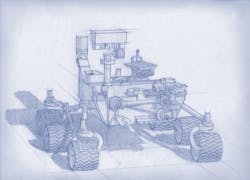PRODUCT APPLICATIONS: EMI shielding technology a must for safety-critical systems engineering
Officials of the Naval Air Warfare Center Aircraft Division at Joint Base McGuire-Dix-Lakehurst, N.J., announced a potential $20.9 million contract to provide as many as 80 new-design shipboard mobile electric power plant (SMEPP) vehicles for Navy ships.
JBT is designing a new SMEPP that is a driveable, four wheel, self-propelled vehicle powered by a diesel engine. The diesel engine not only will be the core of the propulsion system, but it also will drive the SMEPP's electric generator.
The company is designing the SMEPP to be as efficient, economical, and environmentally friendly as possible, and to meet military standards to withstand the effects of shipboard shock and vibration, temperature extremes, humidity and salt spray, and electro-magnetic interference (EMI).
The new JBT SMEPP vehicle will meet MIL-STD-704F for aircraft power characteristics and EPA tier 3 emission standards, and provide three aircraft servicing power outputs: 115 volts AC, three phase, 400 Hz; 28 volts DC; and 270 volts DC. JBT's SMEPP will be equipped with internally stored output power cables without reels that can connect to all existing Navy and Marine Corp aircraft. The power-supply units will incorporate the latest engine, power generation, and power conditioning technologies, and will be transportable in aboard C-5, C-17, C-130, and H-53 military fixed-wing aircraft and heavy-lift helicopters.
JBT Corp. is no stranger to military aircraft support equipment. In 2009 and 2010 the company won Navy contracts to build land-based air conditioner units to support Navy C-130, C-40, C-9, P-8, and P-3 aircraft, as well as supply conditioned air to aircraft equipment and avionics compartments during ground maintenance. In 2008 the company won a $44.6 million U.S. Air Force contract to provide Halvorsen aircraft cargo loaders.
On this contract the Navy will pay JBT Corp. $6.3 million up-front, with the remaining payment depending on the number of SMEPP units ordered. JBT will do the work in Ogden, Utah, and should be finished by December 2019.
For more information, visit JBT Corp. online at www.jbtcorporation.com, or the Naval Air Warfare Center Aircraft Division-Lakehurst at www.navair.navy.mil.
JPL selects Interpoint products from Crane Aerospace & Electronics for Mars 2020
Crane Aerospace & Electronics won a multi-million-dollar contract from the Jet Propulsion Laboratory (JPL) in Pasadena, Calif., to supply power converters for the Mars 2020 mission.
JPL will use a variety of space DC-DC converters and filters including the SMRT product, which provides a built-in EMI filter, independent outputs, and the ability to adjust the output voltage. Other models to be used include SLH, SMSA, SMHF, SMTR, and SMFL, as well as three different EMI filter models.
The previous Mars rovers Opportunity, Spirit, and Curiosity have all used Interpoint space-qualified dc-dc converters. Interpoint converters are available with a variety of screening options up to MIL-PRF-38534 Class K and a variety of radiation-hardness assurance (RHA) options up to RHA R, 100 krad(Si) at both high- and low-dose rates.
“We are very pleased with this contract selection and proud of our proven heritage on previous Mars missions,” says Ed Fuhr, vice president of Power Solutions.
JPL manages the Mars 2020 Project for NASA's Science Mission Directorate in Washington. The California Institute of Technology in Pasadena manages JPL for NASA. The 2020 mission will build on the achievements of Curiosity and other Mars missions, and offer opportunities to deploy new capabilities developed through investments by NASA's Space Technology Program, Human Exploration and Operations Mission Directorate, and contributions from international partners.

